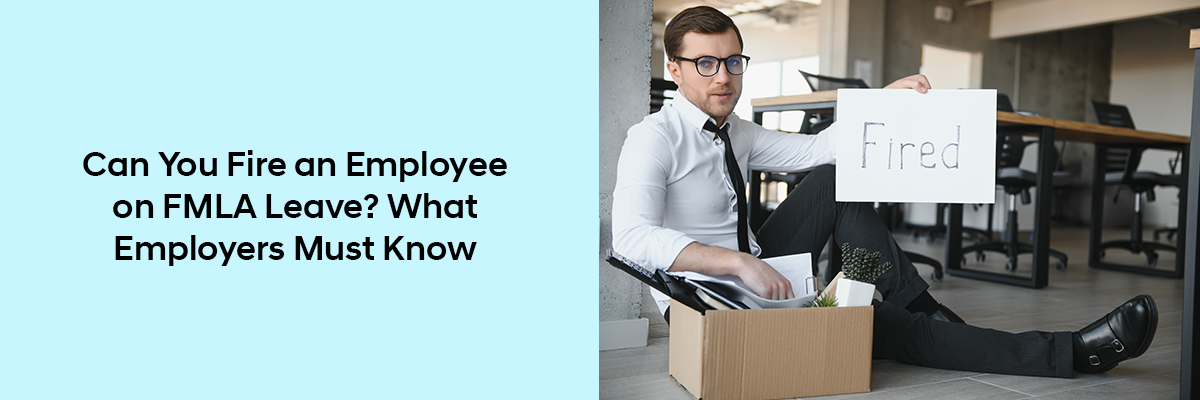Managing employees is never an easy task, and when it comes to handling leaves under the Family and Medical Leave Act (FMLA), things can get even more complicated. One question many employers ask is: Can you fire an employee who is on FMLA leave?
At first glance, the simple answer might seem like a “no”, but the reality is more nuanced. Firing someone while they are on FMLA leave can lead to legal trouble if it’s not handled correctly, but there are also situations where termination is legally allowed. To avoid costly mistakes, employers need to clearly understand the rules.
Let’s break this down step by step.



Understanding FMLA Leave
The FMLA is a federal law that allows eligible employees up to 12 weeks of unpaid, job-protected leave in a 12-month period for specific family and medical reasons. These include:
- The birth or adoption of a child.
- Caring for a seriously ill family member.
- The employee’s own serious health condition.
- Certain military-related needs.
Job protection under FMLA means that when employees return, they should either get their exact job back or an equivalent one with similar pay, benefits, and responsibilities.
This is where the confusion starts, because “job protection” doesn’t mean immunity from being fired under all circumstances.
Can You Fire an Employee on FMLA Leave?
The short answer is: yes, but only under very specific conditions. Employers cannot fire an employee because they took FMLA leave, that would be retaliation, which is illegal. But if there are legitimate, unrelated reasons for termination, then it may be allowed.
Situations where termination is NOT allowed:
- Firing someone simply because they requested or used FMLA leave.
- Retaliating against an employee for exercising their FMLA rights.
- Using their absence as the main reason for termination.
Situations where termination may be allowed:
- The employee’s job would have been eliminated regardless of their FMLA leave (e.g., company-wide layoffs or restructuring).
- The employee violated company policies unrelated to FMLA (e.g., misconduct, fraud, performance issues documented before the leave).
- The employee exceeds their 12 weeks of FMLA leave and cannot return to work.
The key point is that the employer must prove the firing was based on legitimate reasons independent of the FMLA leave.
To know more about Difference Between FMLA and Intermittent FMLA, do give our in- depth blog a read.
Best Practices for Employers
If you are considering termination of an employee on FMLA leave, you must proceed carefully. Here are a few important steps:
- Document everything: Keep records of performance issues, disciplinary actions, or restructuring plans that existed before the FMLA leave request. This helps show the decision wasn’t based on the leave itself.
- Be consistent: Apply company policies the same way to all employees. If you fire one employee for violating a rule but ignore the same behavior in others, it can look like discrimination or retaliation.
- Consult HR or legal experts: FMLA cases can be legally sensitive. Getting professional advice ensures you don’t unintentionally cross the line.
- Communicate clearly: If termination does occur, explain the reasons in writing and make sure they are unrelated to FMLA leave. Avoid vague wording that could be misinterpreted.
- Consider alternatives: If possible, explore accommodations or extended leave under the Americans with Disabilities Act (ADA) before moving to termination. Sometimes, collaboration avoids conflict.
To know more about Difference Between FMLA and Intermittent FMLA, do give our in- depth blog a read.
Conclusion
So, can you fire an employee on FMLA leave? Yes, but only if the reason has nothing to do with their leave. Employers cannot punish or retaliate against someone for using their legal right to FMLA. However, if there are valid business reasons, such as company downsizing, prior misconduct, or policy violations, then termination may be legally permissible.
The most important thing for employers is to handle these cases carefully: keep proper documentation, follow consistent policies, and seek professional guidance when in doubt. Acting too quickly or without evidence can easily lead to costly lawsuits and damage to your company’s reputation.
At the end of the day, FMLA is about balancing employee rights with employer responsibilities. By understanding the law and acting fairly, employers can protect their business while respecting employees’ need for medical and family leave.
To know more about FMLA and Employee Burnout, do give our in- depth blog a read. If you found this blog valuable and informative, and you’d like to explore HR topics in more depth, directly from experienced HR professionals, be sure to check out our human resources webinars.


